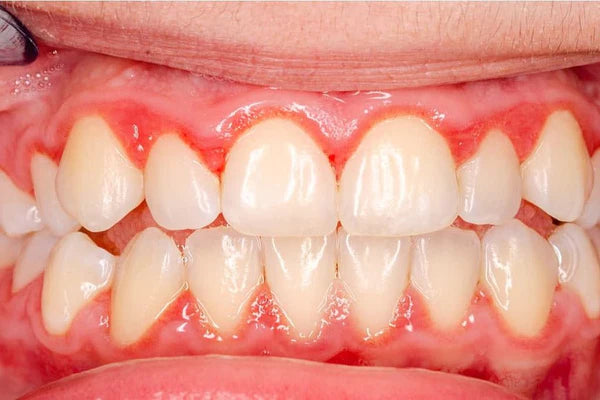Periodontology is a field that is increasingly in demand today by many patients suffering from periodontitis, which can manifest itself as inflammation of the gum area and periodontal tissue. The gums need care in your oral health, just like the teeth. In this article, we will understand laser treatment to solve periodontal problems. Constant pain in the gums, bleeding and a feeling of weakened teeth should be warning signs. If you have any of these symptoms, you may have periodontal disease. Even if the discomfort is minimal at first, the consequences later on can be serious, so it's important to understand them so you can take the necessary measures as soon as possible. Let's take a closer look at what it is and whether laser therapy can be used as a form of treatment for periodontal problems.
Here are the reasons why periodontitis can be treated with laser.
Understanding periodontal problems
But what are they anyway? Periodontal disease is a distinct clinical entity that affects the periodontium, the tissue around the teeth. The initial phase is gingivitis, when the gums become swollen, and if not treated properly, it can progress to a more advanced state, periodontitis. That's why it's important not to ignore problems that occur in your gums. Regardless of the extent of the problem, you should consult a dentist quickly.
What is periodontitis?
This disease can be characterized by loosening of the teeth, or dental tissue that becomes soft and sensitive. It is a severe form of gingivitis, in which the inflammation of the gums spreads to all the supporting structures of the tooth. Plaque and tartar build up between the teeth and gums and spread to the bone under the teeth. The gums become swollen and bleed, the person has bad breath and the teeth become loose. The dentist takes x-rays and measures the depth of the periodontal pockets in the gums to determine the severity of the periodontitis. Periodontitis does not cause significant pain! Contrary to dental caries, pain is not a good indicator in the detection of tooth decay.
The symptoms of periodontitis :
- A red gum: this symptom is only non-existent in a patient who smokes and whose gum, even if sick, does not change color.
- Bleeding gums: they bleed when brushing or completely spontaneously.
- Gums that recede: the root of the teeth becomes visible and the teeth become longer.
- Tooth sensitivities: to hot and cold when eating (slight pain reminiscent of small cavities).
Learn about the possible complications of periodontitis
The consequences of this disease can be quite complicated. Periodontal problems can cause bleeding in the gums at an early stage and can progress to loss of insertion of dental elements. This loss can lead to increased mobility of the teeth, causing them to soften or even be lost in the most severe cases. Dangerous, right?
Periodontal disease is one of the main causes of tooth loss and still affects a large part of the population. Take good care of your oral health and stay out of it!
Can the laser be used to treat periodontal problems?
Treatments for this condition are based on the control of dental biofilm, also called bacterial plaque. They may involve instrumentation of tooth and root surfaces with scaling and ultrasound, periodontal surgery and, in earlier cases, oral hygiene instructions to the patient.
In the arsenal available for biofilm control, laser treatment is one of the therapeutic possibilities. The first step should always be to seek the help of a dentist or a periodontic professional, to indicate and perform the most appropriate procedure.
Diet after laser treatment
- Foods rich in vitamin C: foods such as kiwis, citrus fruits and strawberries promote the formation of collagen and inhibit the resorption of periodontal bone.
- Foods rich in vitamin D: foods such as cod liver oil, fatty fish: herring, mackerel, sardines, anchovies, salmon promotes its fixation on the bones. Its role is anti-inflammatory.
- Foods rich in vitamin B9 or folic acid found in spinach, salads and mushrooms) increases the gain of clinical attachment after periodontal treatment.
-
Foods rich in vitamin E (found in cereals and vegetable oils) improves healing by its anti-oxidant action towards the reactive oxygen derivatives (or ROS) produced by the paro-pathogenic microbes.
Oral hygiene to protect yourself from the problem
If you want to stay away from all of these problems, the way to prevent them is very simple. Just be aware of your oral hygiene with already known attitudes: always start with flossing, one of the main weapons against bad bacteria; brush your teeth with a soft brush and a proper toothpaste, clean your gums, and go to the dentist regularly. In addition, it is important to maintain a balanced diet, without excessive consumption of sweets. With this basic care, you can keep your smile free of these problems.
Technology has evolved so much these days. Laser is indeed a form of treatment for periodontal disease, and can help you improve the surface of your gums. But, remember that only a dentist specialized in periodontics is able to give after diagnosis, the best appropriate treatment for your problem.
The Y-Brush toothbrush has several modes of sonic vibration and brushing time which allows an automation of the gesture and duration. The mode of vibration chosen depends on the dental sensitivity of each or the need for brushing.
We hope that this guide will help you understand what periodontal problems are in general. We also hope that you understand what periodontitis is and the possible complications. Laser treatment, if recommended by your doctor, is a good way to treat periodontal problems. A good diet and good oral hygiene are also good ways to treat periodontitis.



